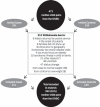Maternal and child awareness and expectations of child overweight
- PMID: 21921653
- PMCID: PMC6444686
- DOI: 10.1159/000331012
Maternal and child awareness and expectations of child overweight
Abstract
Objective: We investigated mothers' and children's assessments of body weight and their expectations about perceived body size in relation to overweight of the children.
Methods: We performed a case-control study of 111 cases of overweight children and 149 controls of non-overweight children (mean age 8.1 years) and their mothers. All were examined and interviewed about their assessment of body weight and their perception of a normal, attractive and acceptable body size.
Results: Case children were less able than control children to correctly assess their own body weight (p < 0.001), as were mothers of overweight children (MOC) to assess their children's body weight (p < 0.001). The majority of mothers from both groups wished their children to have a normal body size, but 18% of MOC wished their children to have an overweight body size (p < 0.013). The majority of case children, control children and mothers found a normal body size for boys and girls to be the most attractive and socially acceptable, but more MOC found overweight among boys to be the most attractive (p = 0.006).
Conclusion: Overweight children and their mothers show increased uncertainty in the assessment of overweight and obesity, but the perception of a normal, attractive and socially acceptable body size is not distorted.
Copyright © 2011 S. Karger AG, Basel.
Figures


References
-
- Lobstein T, Baur L, Unuy R. Obesity in children and young people: a crisis in public health. Obesity Reviews. 2004;5:4–84. - PubMed
-
- Wang Y, Lobstein T. Worldwide trends in childhood overweight and obesity. Int J Pediatr Obes. 2006;1:11–25. - PubMed
-
- WHO: European Ministerial Conference on Counteracting Obesity Diet and Physical Activity for Health. Istanbul, Turkey, 2006. European Charter on Counteraction Obesity. WHO. 2006:pp. 1–5.
-
- Summerbell CD, Waters E, Edmunds L, Kelly SAM, Brown T, Campbell KJ. Interventions for preventing obesity in children. Cochrane Database Syst Rev. 2005;((3)):CD001871. - PubMed
-
- Oude Luttikhuis H, Baur L, Jansen H, Shrewsbury VA, O’Malley C, Stolk RP, Summerbell CD. Interventions for treating obesity in children. Cochrane Database Syst Rev. 2009;((1)):CD001872. - PubMed
Publication types
MeSH terms
LinkOut - more resources
Full Text Sources
Medical

